CLEAN-India Action for
Water
- Drinking water
conservation, augmentation and quality improvement |
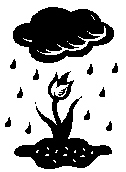 |
Meghna Das
mdas@devalt.org |
Water,
Paani, Jal, Tanni, Líeau, Wasser, Acqua.. perhaps
the most familiar and widely used word in the world. Water needs no
introduction, the importance of this elixir of life is known to one and
all. However, despite water being the basic human need, this precious
resource is being wasted, polluted and getting depleted.Water
pollution, unavailability of drinking water, inadequate sanitation, open
dumping of wastes,
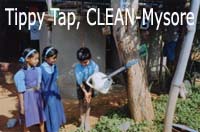 loss of forest cover are some of the problems faced
by many parts of India. Heavy toll of infant mortality due to water
borne diseases, the daily struggle for procuring water, mismanagement of
waste water, improper sanitation are common features and are leading to
serious consequences on human health and the economy of the country. loss of forest cover are some of the problems faced
by many parts of India. Heavy toll of infant mortality due to water
borne diseases, the daily struggle for procuring water, mismanagement of
waste water, improper sanitation are common features and are leading to
serious consequences on human health and the economy of the country.
The situation
demands immediate intervention in the management of these rapidly
growing problems, especially through an integrated approach for water,
sanitation and related issues. What is required is a community based
problem solving approach to help the community groups understand local
issues and take necessary initiatives to improve their local conditions.
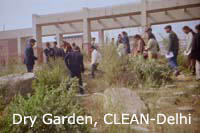 The
CLEAN-India programme spread across 78 Indian towns and cities, serves
as a platform for taking community based remedial actions for drinking
water conservation, augmentation and quality improvement. Some
initiatives of CLEAN-India in the various parts of the country are
listed below: The
CLEAN-India programme spread across 78 Indian towns and cities, serves
as a platform for taking community based remedial actions for drinking
water conservation, augmentation and quality improvement. Some
initiatives of CLEAN-India in the various parts of the country are
listed below:
Water
Conservation / Quantity Augmentation
Tap Water and
Roof top Rain Water Harvesting: Many schools in the CLEAN cities and
towns have channelized the waste water from water drinking points/taps
to gardens or are diverting the water for ground water recharge. Roof
top rain water harvesting is also being taken up as a major measure.
Tippy Tap for
water conservation: An initiative of CLEAN-Mysore, Tippy Tap
is a simple device which dispenses a limited amount of water slowly and
facilitates a thorough hand wash. In case of piped water supply, every
time the tap is opened for a hand wash, an average of 300 - 500 ml of
water is utilized. Using Tippy Tap it is possible to have a good
hand wash with only 60 to 80 ml of water, thus conserving water to a
large extent.
|
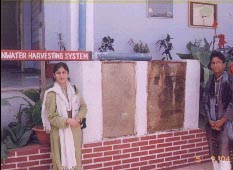 |
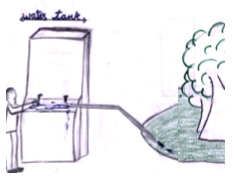 |
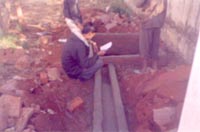 |
|
Rain Water
Harvesting, CLEAM-Gwalior |
Tap Water
Harvesting |
Construction of
Soakpit |
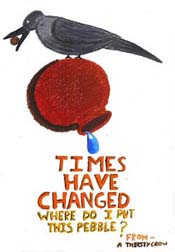 Propagation of Dry Garden / Eco Lawns: As a step towards water
conservation and propagation of native plant species, drought resistant
plantation (plants requiring less water) has been carried out in one of
the schools of CLEAN-Delhi. Propagation of Dry Garden / Eco Lawns: As a step towards water
conservation and propagation of native plant species, drought resistant
plantation (plants requiring less water) has been carried out in one of
the schools of CLEAN-Delhi.
Soak pit
construction: Water run offs and water logging are combated by
constructing soak pits near water points like hand pumps. This is a
sanitation measure and also helps in recharge of ground water. CLEAN-
Amreli, Jhansi, Varanasi are some centres where such initiatives have
been taken.
Tree
plantation in water catchment area / river banks and Clean-up
drives near water bodies are some of the other initiatives taken up
to preserve our water resources.
Water
Quality Improvement
Maintaining
the quality of drinking water is of prime importance to ensure safe
drinking water to the end consumer. The best way to ensure that drinking
water is safe is to either protect it from contamination or treat it
before use and maintain the quality till consumption.
There are
basic treatment methods like boiling, sedimentation, filtration and
chlorination which can be applied for any kind of water but specific
purification technologies exist as per the contaminants and their extent
of pollution in water.
Hence,
incorporation of purification techniques would depend on:
|
l |
Type of technology to be
used |
| |
‹ |
raw water
characteristics ; kind of contaminant; extent of contamination |
| |
‹ |
location of raw water
source |
| |
‹ |
infrastructure: power,
trained manpower and availability of chemicals and /or spares
|
|
l
|
Profile of the water
users |
| |
‹ |
affordability / cost:
Initial and Operation & Maintenance costs. |
| |
‹ |
acceptability: taste of
water, ease of use, maintenance, durability |
|
l |
Level of application:
domestic/household, community/large scale installations
|
|
l |
Sustainability: would
depend on communityís willingness to participate in cost-sharing and
bearing full maintenance cost, and awareness of the related issues. |
CLEAN-India is actively
involved in Drinking Water Quality Monitoring in major towns and cities
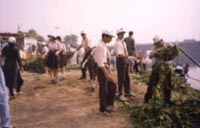 of the country with the help of Jal-TARA water testing kit. Based on the
data obtained on the level of pollutants in water, treatment methods are
suggested and implemented. Some of the treatment methods that are
recommended through the CLEAN-India network are listed in the table. of the country with the help of Jal-TARA water testing kit. Based on the
data obtained on the level of pollutants in water, treatment methods are
suggested and implemented. Some of the treatment methods that are
recommended through the CLEAN-India network are listed in the table.
q
|
Drinking Water Treatment Methods |
|

|
|
FLUORIDE IN WATER ? |
|
Sources: Sources of
fluoride may be geological or anthropogenic (man-made). Weathering
of fluoride bearing minerals (Fluorite, Fluorspar, Cryolite,
Fluorapatite, Ralstonite and others) in the earthís crust can lead
to higher fluoride levels in groundwater. Further, overexploitation
of Ground Water aggravates the problem of F concentration in water
even more.
Man made sources include
fluorides added to certain pharmaceutical products (for treating
hyperthyroidism), medicines, tooth pastes, insecticides,
disinfectants, preservatives, super phosphate fertilizer, vitamin
supplements and others.
Health Effects:
Long term excess
fluoride intake (more than 1.5 mg/l) leads to 3 types of
abnormalities
|
l |
Dental fluorosis
(teeth): Leads to damaged, discoloured teeth as fluoride poisons
the enamel forming cells. |
|
l |
Skeletal fluorosis
(bones): Leads to backache, pain in neck, shoulders and knee
joints. In higher concentrations, it leads to crippling disease. |
|
l |
Non Skeleton
manifestations (soft tissue and organs): Muscle fatigue, stomach
problems, anemia, neurological manifestations. |
Detection: The permissible
limit for Fluoride in water, according to WHO is 1.5 mg/l. The Jal
TARA Fluoride testing kit helps detect Fluoride in water (refer back
page)
Drinking water treatment:
One of the
options for treatment of fluoride in water in the rural set up is
the use of Domestic Defluoridation Units (DDUs). Treatment may be
based on the principle of adsorption using Activated Alumina
technology or Nalgonda technology. Hand pump attached systems can
also be incorporated at the community level.
For more details mail us at
temf@devalt.org
|
|
ARSENIC IN WATER ? |
|
Sources: It is naturally
present in the earthís crust. It may be found in water which
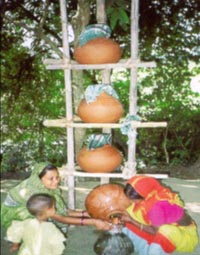 has
flowed through arsenic rich rocks. There are many hypotheses
available for presence of Arsenic in water especially with the
rising concern of its spread in the Gangetic basin. Deltaic and
alluvial silts are also known to contain arsenic bearing rocks.
Industrial effluents too contribute arsenic to water in some areas. has
flowed through arsenic rich rocks. There are many hypotheses
available for presence of Arsenic in water especially with the
rising concern of its spread in the Gangetic basin. Deltaic and
alluvial silts are also known to contain arsenic bearing rocks.
Industrial effluents too contribute arsenic to water in some areas.
Health effects: Symptoms of
acute arsenic poisoning typically include vomiting, oesophagal and
abdominal pain, and bloody "rice water" diarrhoea. Long-term
exposure to arsenic via drinking-water causes cancer of the skin,
lungs, urinary bladder, and kidney, as well as other skin changes
such as pigmentation changes and thickening (hyperkeratosis) and
ultimately leading to gangrene.
Detection: The permissible
limit for Arsenic in water, according to WHO is 10 parts per
billion. The Jal TARA Arsenic testing kit helps detect Arsenic in
water (refer back page)
Drinking water treatment:
One of the systems available for the rural set up is the 3 pot/
Kalshi system. The topmost pot is filled with Iron filings and
coarse sand, the middle pot consists of fine sand and wood charcoal
while the last pot serves as the collector of treated water. Other
than these, there are also available Household Biosand Filters (HBF)
and Domestic Activated Alumina based filters for Arsenic removal.
For more details mail us at
temf@devalt.org |
Back to Contents |

 loss of forest cover are some of the problems faced
by many parts of India. Heavy toll of infant mortality due to water
borne diseases, the daily struggle for procuring water, mismanagement of
waste water, improper sanitation are common features and are leading to
serious consequences on human health and the economy of the country.
loss of forest cover are some of the problems faced
by many parts of India. Heavy toll of infant mortality due to water
borne diseases, the daily struggle for procuring water, mismanagement of
waste water, improper sanitation are common features and are leading to
serious consequences on human health and the economy of the country. The
CLEAN-India programme spread across 78 Indian towns and cities, serves
as a platform for taking community based remedial actions for drinking
water conservation, augmentation and quality improvement. Some
initiatives of CLEAN-India in the various parts of the country are
listed below:
The
CLEAN-India programme spread across 78 Indian towns and cities, serves
as a platform for taking community based remedial actions for drinking
water conservation, augmentation and quality improvement. Some
initiatives of CLEAN-India in the various parts of the country are
listed below:


 Propagation of Dry Garden / Eco Lawns: As a step towards water
conservation and propagation of native plant species, drought resistant
plantation (plants requiring less water) has been carried out in one of
the schools of CLEAN-Delhi.
Propagation of Dry Garden / Eco Lawns: As a step towards water
conservation and propagation of native plant species, drought resistant
plantation (plants requiring less water) has been carried out in one of
the schools of CLEAN-Delhi.  of the country with the help of Jal-TARA water testing kit. Based on the
data obtained on the level of pollutants in water, treatment methods are
suggested and implemented. Some of the treatment methods that are
recommended through the CLEAN-India network are listed in the table.
of the country with the help of Jal-TARA water testing kit. Based on the
data obtained on the level of pollutants in water, treatment methods are
suggested and implemented. Some of the treatment methods that are
recommended through the CLEAN-India network are listed in the table.

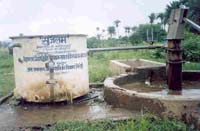
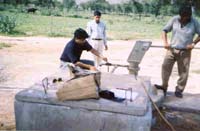
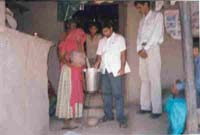
 has
flowed through arsenic rich rocks. There are many hypotheses
available for presence of Arsenic in water especially with the
rising concern of its spread in the Gangetic basin. Deltaic and
alluvial silts are also known to contain arsenic bearing rocks.
Industrial effluents too contribute arsenic to water in some areas.
has
flowed through arsenic rich rocks. There are many hypotheses
available for presence of Arsenic in water especially with the
rising concern of its spread in the Gangetic basin. Deltaic and
alluvial silts are also known to contain arsenic bearing rocks.
Industrial effluents too contribute arsenic to water in some areas.